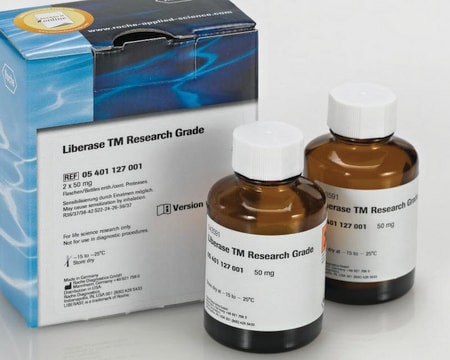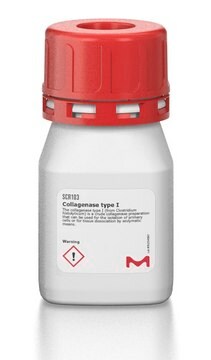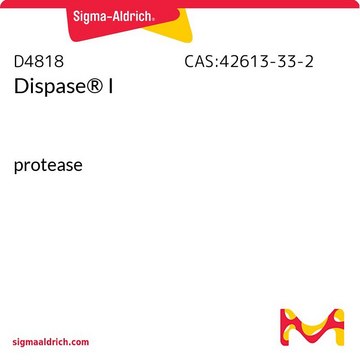COLLP-RO
Roche
Collagenase P
from Clostridium histolyticum
About This Item
Recommended Products
biological source
Clostridium histolyticum
Quality Level
sterility
non-sterile
form
lyophilized
collagenase activity
>1.5 U/mg (Lyophilizate, Collagenase activity)
packaging
pkg of 1 g (11249002001)
pkg of 100 mg (11213857001)
pkg of 2.5 g (11213873001)
pkg of 500 mg (11213865001)
manufacturer/tradename
Roche
concentration
0.5-2.5 mg/mL
technique(s)
tissue processing: suitable
color
light brown to brown
solubility
water: soluble
NCBI accession no.
application(s)
life science and biopharma
foreign activity
Clostripain 24.099 U/mg
Protease 4.4 U/mg (Proteases)
Trypsin 53.428 U/mg (with BAEE)
storage temp.
2-8°C
Related Categories
General description
Note: Collagenase P is a non-sterile preparation of the culture supernatant of Clostridium histolyticum. It is neither designed nor intended for isolation of pancreatic islets for transplantation into humans and must not be used for such purposes.
Specificity
Collagenase activity: >1.5U/mg (according to Wünsch) (+25°C, 4-phenyl-azobenzyl-oxycarbonyl-Pro-Leu-Gly-Pro-D-Arg as the substrate)
Contaminating enzyme activities: trypsin, clostripain, and total proteolytic activity
Collagenase P has a very high collagenase activity (>1.5U/mg), and is function tested for the isolation of mouse pancreatic islets.
Specificity: Collagenase degrades native collagen. Clostripain, trypsin-like enzymes, and neutral proteases degrade other proteins as well.
Application
Features and Benefits
Lyophilizate, nonsterile
Preparation Note
Inhibitors:
Collagenase inhibitors: EDTA, EGTA, Cys, His, DTT, 2-mercaptoethanol
Collagenase is not inhibited by serum.
Clostripain inhibitors: TLCK
Trypsin inhibitors: aprotinin, trypsin inhibitor (egg white, soybean)
Working concentration: 0.5 to 2.5mg/ml
0.5 to 1.5mg/ml for the isolation of pancreatic islets from mouse and rat pancreas.
Approximately 2mg/ml for the isolation of adipocytes.
Storage conditions (working solution): -15 to -25°C
The reconstituted solution is stable at -15 to -25°C. Prepare appropriate aliquots and avoid repeated freezing and thawing.
Reconstitution
Storage and Stability
Other Notes
signalword
Danger
Hazard Classifications
Eye Irrit. 2 - Resp. Sens. 1 - Skin Irrit. 2 - STOT SE 3
target_organs
Respiratory system
Storage Class
11 - Combustible Solids
wgk_germany
WGK 1
flash_point_f
does not flash
flash_point_c
does not flash
Certificates of Analysis (COA)
Search for Certificates of Analysis (COA) by entering the products Lot/Batch Number. Lot and Batch Numbers can be found on a product’s label following the words ‘Lot’ or ‘Batch’.
Already Own This Product?
Find documentation for the products that you have recently purchased in the Document Library.
Customers Also Viewed
Articles
Enzyme Explorer Key Resource: Collagenase Guide.Collagenases, enzymes that break down the native collagen that holds animal tissues together, are made by a variety of microorganisms and by many different animal cells.
Related Content
Collagenase Guide.Collagenases, enzymes that break down the native collagen that holds animal tissues together, are made by a variety of microorganisms and by many different animal cells.
Our team of scientists has experience in all areas of research including Life Science, Material Science, Chemical Synthesis, Chromatography, Analytical and many others.
Contact Technical Service














